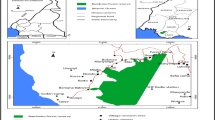Abstract
The purpose of this paper is to understand why non-timber forest products (NTFPs) are not integrated into the development agendas of official institutions. Fieldwork was conducted in September 2015 and March and April 2016 in Phnom Prich Wildlife Sanctuary, using participatory rural appraisals and structured questionnaire interviews with randomly selected 310 households. The results of the study are reported. In the survey area, eight NTFPs were identified as the most important for the daily life of local people. Many NTFPs were self-sufficiently collected and consumed by the surveyed households. Regarding the institutional management of NTFPs, the local institutions play the greatest role to enhance NTFPs’ sustainable use. The government was not sufficiently involved in the regulation and management of NTFPs. As a result of the examination, the reason for the absence of NTFPs from national policies and strategies is the insufficient information available regarding both their value as subsistence and trading products and their contribution to rural livelihoods.


Similar content being viewed by others
References
Belcher, B., Ruiz-Perez, M., & Achdiawan, R. (2005). Global patterns and trends in the use and management of commercial NTFPs: Implications for livelihoods and conservation. World Development, 33, 1435–1452. https://doi.org/10.1016/j.worlddev.2004.10.007.
Belcher, B., & Schreckenberg, K. (2007). Commercialisation of non-timber forest products: A reality check. Development Policy Review, 25(3), 355–377.
Berg, J. V. D., Wiersum, K. F., & Kijk, H. V. (2007). The role and dynamics of community institutions in the management of NTFP resources. Forest, Trees and Livelihoods, 17, 183–197.
Cavendish, W. (2002). Quantitative methods for estimating the economic value of resource use to rural households. In B. M. Campbell & M. K. Luckert (Eds.), Uncovering the hidden harvest: Valuation methods for woodland and forest resources (pp. 17–65). London: Earthscan Publication Ltd.
Chou, P. (2018). Uncovering the hidden value of non-timber forest products from a poverty alleviation perspective: Evidence from Phnom Prich Wildlife Sanctuary, Cambodia. Forum of International Development Studies, 48, 1–22.
De Beer, J. H., & McDermott, M. J. (1996). The economic value of non-timber forest products in Southeast Asia (2nd ed.). Amsterdam: Netherlands Committee for IUCN.
FAO. (2016). Global forest reesources asssessment 2015: How are the world’s forests changing? (2nd ed.). Rome: Food and Agriculture Organization of the United Nations.
Ghate, R., Mehra, D., & Nagendra, H. (2009). Local institutions as mediators of the impact of markets on non-timber forest product extraction in Central India. Environmental Conservation, 36(1), 51–61.
Gray, T. N. E. (2011). Habitat preferences and activity patterns of the larger mammal community in Phnom Prich Wildlife Sanctuary, Cambodia. The Raffles Bulletin of Zoology, 59(2), 311–318.
International Institute for Environment and Development (IIED). (1992). The hidden harvest: Wild foods and agricultural systems. London: The Sustainable Agriculture Programme, IIED.
Milne, S., & Mahanty, S. (2015). Conservation and development in Cambodia: Exploring frontiers of change in nature, state and society. New York: Routledge.
Ministry of Agriculture, Forestry and Fisheries (MAFF). (2005). PRAKAS: On non-timber forest products. (No. 132 RBK/KSK). Phnom Penh: MAFF-Cambodia.
Ministry of Planning of Cambodia (MOP). (2013). Cambodia inter-censal population survey of Cambodia 2013. Retrieved March 5, 2016, from https://www.nis.gov.kh/nis/CensusInfo2.0/index.htm.
Moran, E. F., & Ostrom, E. (2005). Seeing the forest and the trees: Human–environment interactions in forest ecosystems. Massachusetts: Massachusetts Institute of Technology Press.
Mutenje, M. J., Ortmann, G. F., & Ferrer, S. R. D. (2011). Management of non-timber forestry products extraction: Local institutions, ecological knowledge and market structure in South-Eastern Zimbabwe. Ecological Economics, 70, 454–461.
Pearce, D. W. (2001). The economic value of forest ecosystems. Ecosystem Health, 7(4), 284–296. https://doi.org/10.1046/j.1526-0992.2001.01037.x.
Ruiz-Pérez, M., Belcher, B., Achdiawan, R., Alexiades, M., Aubertin, C., Caballero, J., Campbell, B., Clement, C., Cunningham, T., Fantini, A., Foresta, H. D., Fernadez, C. G., Gautam, K. H., Martinez, P. H., Jong, W. D., Kusters, K., Kutty, M. G., Lopez, C., Fu, M., Alfaro, M. A. M., Nair, T. K. R., Ndoye, O., Ocampo, R., Rai, N., Ricker, M., Schreckenberg, K., Shackleton, S., Shanley, P., Sunderland, T., and Youn, Y. C. (2004). Markets drive the specialization strategies of forest peoples. Ecology and Society, 9(2). Retrieved January 20, 2016, from https://www.ecologyandsociety.org/vol9/iss2/art4/.
Shackleton, C. M., & Pandey, A. K. (2014). Positioning non-timber forest products on the development agenda. Forest Policy and Economics, 38, 1–7.
Shackleton, S., Shackleton, C., & Shanley, P. (2011). Non-timber forest products in the global context. Heidelberg: Springer.
Sills, E., Shanley, P., Paumgarten, F., Beer, J. D., & Pierce, A. (2011). Evolving perspectives on non-timber forest products. In S. Shackleton, C. Shackleton, & P. Shanley (Eds.), Non-timber forest products in the global context (pp. 23–50). Heidelberg: Springer.
Stack, J., Dorward, A., Gondo, T., Frost, P., Taylor, F., & Kurebgaseka, N. (2003). Mopane worm utilisation and rural livelihoods in Southern Africa. In Paper presented at the international conference on rural livelihoods, forests and biodiversity, Bonn, Germany.
Uphoff, N. (1992). Local institutions and participation for sustainable development gatekeeper series, no. SA31. London: International Institute for Environment and Development (IIED).
Vantomme, P., Markkula, A., & Leslie, R. N. (2002). Non-wood forest products in 15 countries of Tropical Asia: An overview. Bangkok: The Food and Agriculture Organization of the United Nations.
Watkins, K., Sovann, C., Brander, L., Neth, B., Chou, P., Hoy, S., et al. (2016). Mapping and valuing ecosystem services in Mondulkiri: Outcomes and recommendations for sustainable and inclusive land use planning in Cambodia. Phnom Penh: WWF Cambodia.
World Wide Fund for Nature (WWF). (2016). Phnom Prich Wildlife Sanctuary. Phnom Penh: WWF-Cambodia.
Author information
Authors and Affiliations
Corresponding author
Appendix: Questionnaire
Appendix: Questionnaire



Rights and permissions
About this article
Cite this article
Chou, P. The utilization and institutional management of non-timber forest products in Phnom Prich Wildlife Sanctuary, Cambodia. Environ Dev Sustain 21, 1947–1962 (2019). https://doi.org/10.1007/s10668-018-0113-3
Received:
Accepted:
Published:
Issue Date:
DOI: https://doi.org/10.1007/s10668-018-0113-3




